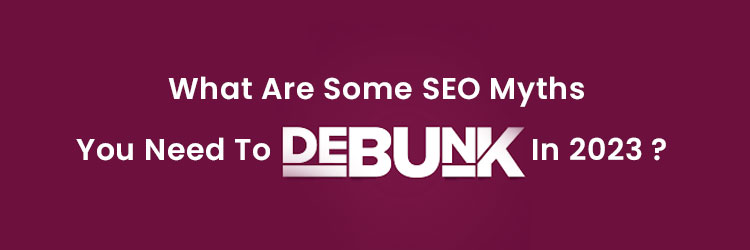SEO Myths To Leave Behind In 2023

Nowadays, with the internet being flooded with hundreds of tips and tricks every day, it is very difficult to pinpoint which is genuine and which is misleading. Only a true SEO expert can shed some light on the myths regarding Search Engine Optimisation so that clients and digital marketers can achieve goals with clarity.
Table of Contents
1. How Do SEO Myths Originate?

SEO practices constantly evolve due to changes in search engine algorithms and industry best practices. SEO is a complex field that involves numerous factors, and search engines like Google do not disclose their algorithms fully. This lack of transparency can result in speculation and guesswork, leading to the formation of myths.
2. What Are Some SEO Myths You Need to Debunk In 2023?

Firstly we all need to accept that completely comprehending how search engines work is impossible. It needs several trials, errors, and experimentation. It is like on-the-job training, i.e., learning by doing. With experience and some common sense, you will gradually develop an SEO acumen fine enough to distinguish between an SEO myth and a fact.
Let’s debunk some SEO myths you should completely ignore.
2.1 Google Uses Google Analytics Data To Rank
It is a general misconception that Google integrates information from Google Analytics into its ranking algorithm to rank websites.
Webmasters often worry that if their Google Analytics data isn’t up to par, like a high bounce rate or a low amount of time spent on a page, Google will think their site isn’t good enough and hurt its rankings.
Using data from Google Analytics as a ranking factor is difficult to contemplate.
You can utilize filters to control the information that causes your site to appear as though it was performing in a way that can differ from reality.
A high bounce rate, for instance, signals that your website lacks quality content or is difficult to use.
However, it could imply that your content is extremely easy to gulp.
If your website isn’t ranking well, the metrics in Google Analytics can help you figure out why, but they can be something other than the real cause.
2.2 Google Is Concerned About Domain Authority
The PageRank algorithm is how Google determines a website’s importance.
On its toolbar, Google used to show a page’s PageRank score, which ranged from 0 to 10.
In 2013, Google stopped showing PageRank in the toolbar, and 2016, Google said that it would no longer use the PageRank toolbar metric.
In most cases, SEO professionals link a website’s backlink profile to its ranking power. This measurement is otherwise called Domain Authority (DA).
Some webmasters now use these scores to determine a page’s value. However, they can’t accurately show how search engines value a page.
2.3 SEO Takes 3 Months To Show Results
Another well-known and unproven myth is that results from SEO services take three months to appear.
SEO efforts indeed take time to pay off, and 3 months is a reasonable amount of time to determine whether your efforts are paying off.
However, the effort is not guaranteed to be profitable for your website.
Google may only require a re-crawl to display ranking changes if you target niche terms and have little competition in your market.
Rankings for a competitive keyword will rise significantly more slowly.
Your website’s SEO can be affected by a number of things. With a minor change in the page title, the CTR can be boosted. That could occur if the web search tool bugs re-crawl the page around the same time.
It may take some time to reach Google’s first-page ranking. Therefore, setting a 3-month timeline for measuring SEO efforts isn’t appropriate.
2.4 A Ranking Factor Is Bounce Rate
A ranking factor is the bounce rate or the percentage of website visitors who exit the site after viewing only one page.
Google Analytics can be used to measure it.
Some accept that bounce rate is a ranking element since it indicates value.
Visitors may want to leave a page as soon as they arrive for several reasons. They could have bread all the data on the page and exited on to contact the business. In that scenario, the bounce has benefited the business.
Visitors may also leave your page if the content on your website is of poor quality.
Subsequently, the bounce rate can’t be considered a quality pointer.
Instead, a visitor clicking on a search result and immediately returning to the SERPs or Pogo-sticking would be a more reliable metric for determining the quality of the landing page.
It suggests that the user has returned to the search results to browse another page or re-search because the content on the page did not satisfy their needs.
2.5 It Revolves Around Backlinks
There’s no second thought that backlinks are fundamental for SEO, yet how much significance they have is something to ponder.
Some will say that backlinks are one of many SEO strategies that improve the site’s ranking, while others will assert that it is the only factor in SEO that matters.
Previously, you could build links anywhere, including online forums, directories, and other places.
However, link building is now difficult due to Google’s frequent algorithm changes.
Google now penalizes spammy links and only rewards relevant and high-quality links.
On cell phones, you can frequently see many results before you arrive at the first organic results.
Important backlinks assist with positioning; however, you can’t depend on them exclusively. You can improve your SERP visibility by optimizing your content, images, videos, and schema.
You need to combine these optimization methods if you want more visitors to become customers and your website to rank higher.
3. Conclusion

Separating SEO fact from fiction is crucial for implementing effective strategies and achieving sustainable results. By debunking these common SEO myths, we aim to empower website owners and marketers to make informed decisions based on accurate information. Remember, staying current with industry trends, following best practices, and providing valuable content and user experience are the keys to success in offering valuable SEO services in today’s dynamic digital landscape.
FACT TIME!
Did you know the top five search engine results receive 75.7 per cent of the clicks? So, concentrate on a few valuable words and construct content around those terms.

Divanshu Sareen
I have an amazing experience working as a BDE at Matebiz. The company has provided me with great opportunities to learn and grow. The working environment is very conducive to learning and the management is very supportive. I would definitely recommend Matebiz to anyone looking for a great place to work.
Recent Blogs
-
 11 Powerful Digital Marketing For Travel Agency Strategies
11 Powerful Digital Marketing For Travel Agency Strategies
-
 Struggling with Leads? A Digital Marketing Agency Dallas Can Fix That
Struggling with Leads? A Digital Marketing Agency Dallas Can Fix That
-
 SEO Services Los Angeles Horror Stories: Costly Mistakes That Hurt Businesses
SEO Services Los Angeles Horror Stories: Costly Mistakes That Hurt Businesses
-
 How to Future-Proof Your Brand Identity for Long-term Success with a Digital Marketing Agency Washington DC
How to Future-Proof Your Brand Identity for Long-term Success with a Digital Marketing Agency Washington DC
-
 How to Create a Winning Digital Strategy with a Digital Marketing Agency New York
How to Create a Winning Digital Strategy with a Digital Marketing Agency New York


